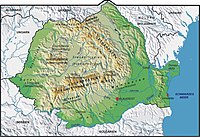
Photo from wikipedia
Abstract The way in which modern humans first entered Europe has been a recent focus of Upper Paleolithic research. A leading theory posits that the Danube served as a conduit… Click to show full abstract
Abstract The way in which modern humans first entered Europe has been a recent focus of Upper Paleolithic research. A leading theory posits that the Danube served as a conduit for migration from Southeastern into Central and Western Europe. However, a challenge to this has been the scarcity of Early Upper Paleolithic sites along the Middle Danube (Carpathian) Basin. Though several sites with Early Upper Paleolithic features (Szeletian, Aurignacian) are known from surface prospections, few have been archeologically investigated in detail. Here, our aim is to elucidate this long-standing deficiency by evaluating two unknown and three known sites from the northern Carpathian Basin in Hungary and Slovakia through a series of “keyhole” excavations. The objectives were to see if in situ stratified material still existed and to characterize the sites’ archeological assemblages and sedimentological contexts. To do this, field observations supplemented by granulometry were employed to determine if the surrounding sedimentary matrix was eolian loess and/or if it had been mixed with underlying older deposits. The results indicate that the lithics represent Early Upper Paleolithic assemblages that experienced post-depositional mixing. However, two sites (Seňa I, Nagyrede 1) showed more nuanced site formation processes and may contain in situ artifacts warranting further exploration. These studies highlight the importance of including sedimentological research into archeological investigations, because the paucity of sites may not simply mean a lack of human occupation, but can indicate a dynamic geomorphological evolution of the Pleistocene landscape that may have erased past traces of human settlements through insufficient sedimentation. The results provide new insights into the Early Upper Paleolithic settlement and the sedimentary dynamics of the Carpathian Basin ultimately leading to a greater understanding of the early modern human settlement patterns in Europe.
Journal Title: Quaternary International
Year Published: 2017
Link to full text (if available)
Share on Social Media: Sign Up to like & get
recommendations!